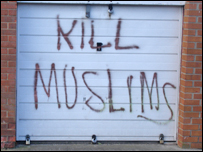Links that Matter
<3> A 53-year-old Bangladeshi imam has been punched and kicked by a man in Glasgow. Witnesses to the attack said the suspect, who was described as white male entered the mosque, verbally abused Imam Shamsuddin before punching and kicking him and then hitting him with a chair and other office equipment. Imam Shamsuddin has been leading prayers at the mosque for seven years. This is perhaps the first report of a Bangladeshi getting assaulted because of the rise of Islamphobia in recent years.

Also, lecturers and university staff across Britain are to be asked to spy on "Asian-looking" and Muslim students they suspect of involvement in Islamic extremism and supporting terrorist violence, the Guardian reported. The Department for Education has drawn up a series of proposals which are to be sent to universities and other centres of higher education before the end of the year. Wakkas Khan, president of the Federation of Student Islamic Societies, said: "It sounds to me to be potentially the widest infringement of the rights of Muslim students that there ever has been in this country. It is clearly targeting Muslim students and treating them to a higher level of suspicion and scrutiny. It sounds like you're guilty until you're proven innocent." Gemma Tumelty, president of the National Union of Students, said: "They are going to treat everyone Muslim with suspicion on the basis of their faith. It's bearing on the side of McCarthyism."
<4> Just a day after the victory from Pakistani occupation, thirty-five years back a grotesque real-life drama was enacted at Dhaka Stadium on December 17, 1971. The actor was freedom fighter Kader Siddiqi, and the victims were two men. Alleged to be Razakars, they were bayoneted to death by Siddiqi in front of a group of cheery crowd of the Muktibahini or the liberation armed groups. Horst Fass and Michel Laurent of Associated Press (AP) have won the Pulitzer Prize by photographing the grotesque killings of the two persons. The horrifying AP photo series "Death in Dacca' haunted the then government. And it was one of the reasons why all the prisoners of war (POW) of 1971 were immediately shifted to India for safety. A repeat performance of the bizarre stage show on October 28 of beating up one man to death by over young men made Dhaka known as a notorious city across the world. On that date Awami League-led 14-party alliance workers swooped upon allegedly one Jamaat worker and beat him to death in broad daylight in presence of many people. Video footage recorded from TV channels of the ghastly murders is now being circulating around the world with a note of caution: Youtube, "This video may contain content that is inappropriate for some users. To view this video, please verify that you are 18 or older".
<5> Karen Armstrong, in her paradox of veiling, argues that where the veil is forbidden, women hasten to wear it and she is proven right by a recent report by BBC - How veil remarks reinforced its support
"When Ataturk secularised Turkey, men and women were forced into European costumes that felt like fancy dress. In Iran, the shahs' soldiers used to march through the streets with their bayonets at the ready, tearing off the women's veils and ripping them to pieces. In 1935, Shah Reza Pahlavi ordered the army to shoot at unarmed demonstrators who were protesting against obligatory western dress. Hundreds of Iranians died that day.
Many women, whose mothers had happily discarded the veil, adopted the hijab in order to dissociate themselves from aggressively secular regimes. This happened in Egypt under President Anwar Sadat and it continues under Hosni Mubarak. When the shah banned the chador, during the Iranian revolution, women wore it as a matter of principle - even those who usually wore western clothes. Today in the US, more and more Muslim women are wearing the hijab to distance themselves from the foreign policy of the Bush administration; something similar may well be happening in Britain."
On the same issue, INDIAKNIGHT in her "Muslims are the new Jews" article says that It’s open season on Islam — Muslims are the new Jews.
"Oppressed women are everywhere: there’s probably one living in your street. She may be a Muslim wearing a veil, or a white woman whose husband beats her. She may be covered from head to toe, dressed like a librarian, or fond of micro-skirts. She may be your mother or your sister. She may be you — regardless of how you dress, what you believe or where you come from. And that is the point. Unhappy, abused people come in all colours, shapes and sizes. It is absurd to suddenly, appoint ourselves moral arbiters, and decree, very loudly, that a piece of fabric is an indicator of an unhappy, down-trodden life.
Happy people come in all formats too. The concept of the men hanging out together while the women “work” in the kitchen may seem peculiar to a non-Muslim — though not that peculiar, given that a less formalised version of the same thing happens whenever you have friends round — but I’ve been to many memorable, jolly parties where gangs of Muslim women ate, gossiped and laughed together without seeming overwhelmingly oppressed, or indeed, oppressed at all.
My experience of Muslim life is not that it is the patriarchal nightmare of legend, but that women are powerful, vocal and iron-fisted beneath their velvet gloves. This is a subjective viewpoint: I am not claiming that every Muslim woman in the world is gloriously carefree. They aren’t (who is?), and I am particularly offended by Straw’s comments because the women Straw described are by and large first-generation immigrants — ie, poor working-class women trying to get on with their lives."







0 Comments:
Post a Comment
<< Home